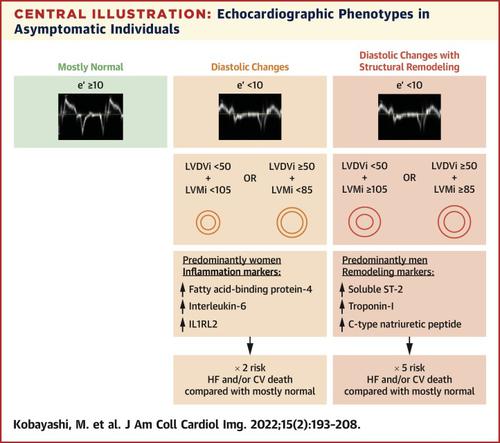JACC: Cardiovascular Imaging ( IF 14.0 ) Pub Date : 2021-09-15 , DOI: 10.1016/j.jcmg.2021.07.004 Masatake Kobayashi 1 , Olivier Huttin 1 , Martin Magnusson 2 , João Pedro Ferreira 1 , Erwan Bozec 1 , Anne-Cecile Huby 1 , Gregoire Preud'homme 1 , Kevin Duarte 1 , Zohra Lamiral 1 , Kevin Dalleau 3 , Emmanuel Bresso 3 , Malika Smaïl-Tabbone 4 , Marie-Dominique Devignes 4 , Peter M Nilsson 5 , Margret Leosdottir 6 , Jean-Marc Boivin 1 , Faiez Zannad 1 , Patrick Rossignol 1 , Nicolas Girerd 1 ,

|
Objectives
This study sought to identify homogenous echocardiographic phenotypes in community-based cohorts and assess their association with outcomes.
Background
Asymptomatic cardiac dysfunction leads to a high risk of long-term cardiovascular morbidity and mortality; however, better echocardiographic classification of asymptomatic individuals remains a challenge.
Methods
Echocardiographic phenotypes were identified using K-means clustering in the first generation of the STANISLAS (Yearly non-invasive follow-up of Health status of Lorraine insured inhabitants) cohort (N = 827; mean age: 60 ± 5 years; men: 48%), and their associations with vascular function and circulating biomarkers were also assessed. These phenotypes were externally validated in the Malmö Preventive Project cohort (N = 1,394; mean age: 67 ± 6 years; men: 70%), and their associations with the composite of cardiovascular mortality (CVM) or heart failure hospitalization (HFH) were assessed as well.
Results
Three echocardiographic phenotypes were identified as “mostly normal (MN)” (n = 334), “diastolic changes (D)” (n = 323), and “diastolic changes with structural remodeling (D/S)” (n = 170). The D and D/S phenotypes had similar ages, body mass indices, cardiovascular risk factors, vascular impairments, and diastolic function changes. The D phenotype consisted mainly of women and featured increased levels of inflammatory biomarkers, whereas the D/S phenotype, consisted predominantly of men, displayed the highest values of left ventricular mass, volume, and remodeling biomarkers. The phenotypes were predicted based on a simple algorithm including e′, left ventricular mass and volume (e′VM algorithm). In the Malmö cohort, subgroups derived from e′VM algorithm were significantly associated with a higher risk of CVM and HFH (adjusted HR in the D phenotype = 1.87; 95% CI: 1.04 to 3.37; adjusted HR in the D/S phenotype = 3.02; 95% CI: 1.71 to 5.34).
Conclusions
Among asymptomatic, middle-aged individuals, echocardiographic data-driven classification based on the simple e′VM algorithm identified profiles with different long-term HF risk. (4th Visit at 17 Years of Cohort STANISLAS-Stanislas Ancillary Study ESCIF [STANISLASV4]; NCT01391442)
中文翻译:

机器学习衍生的超声心动图表型预测无症状个体的心力衰竭发病率
目标
本研究旨在确定基于社区的队列中的同质超声心动图表型,并评估它们与结果的关联。
背景
无症状的心功能不全导致长期心血管发病率和死亡率的高风险;然而,对无症状个体进行更好的超声心动图分类仍然是一个挑战。
方法
在第一代 STANISLAS(洛林投保居民健康状况的年度无创随访)队列(N = 827;平均年龄:60 ± 5 岁;男性:48% ),并评估了它们与血管功能和循环生物标志物的关联。这些表型在马尔默预防项目队列(N = 1,394;平均年龄:67 ± 6 岁;男性:70%)中得到了外部验证,它们与心血管死亡率 (CVM) 或心力衰竭住院 (HFH) 的复合相关性为也进行了评估。
结果
三种超声心动图表型被确定为“大部分正常 (MN)” (n = 334)、“舒张期变化 (D)” (n = 323) 和“伴随结构重塑的舒张期变化 (D/S)” (n = 170) . D 和 D/S 表型具有相似的年龄、体重指数、心血管危险因素、血管损伤和舒张功能变化。D 表型主要由女性组成,炎症生物标志物水平升高,而 D/S 表型主要由男性组成,显示左心室质量、体积和重塑生物标志物的最高值。基于包括 e'、左心室质量和体积的简单算法(e'VM 算法)预测表型。在马尔默队列中,
结论
在无症状的中年个体中,基于简单 e'VM 算法的超声心动图数据驱动分类识别出具有不同长期 HF 风险的特征。(第 17 年队列 STANISLAS-Stanislas 辅助研究 ESCIF [STANISLASV4] 的第四次访问;NCT01391442)


























 京公网安备 11010802027423号
京公网安备 11010802027423号